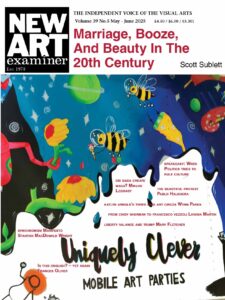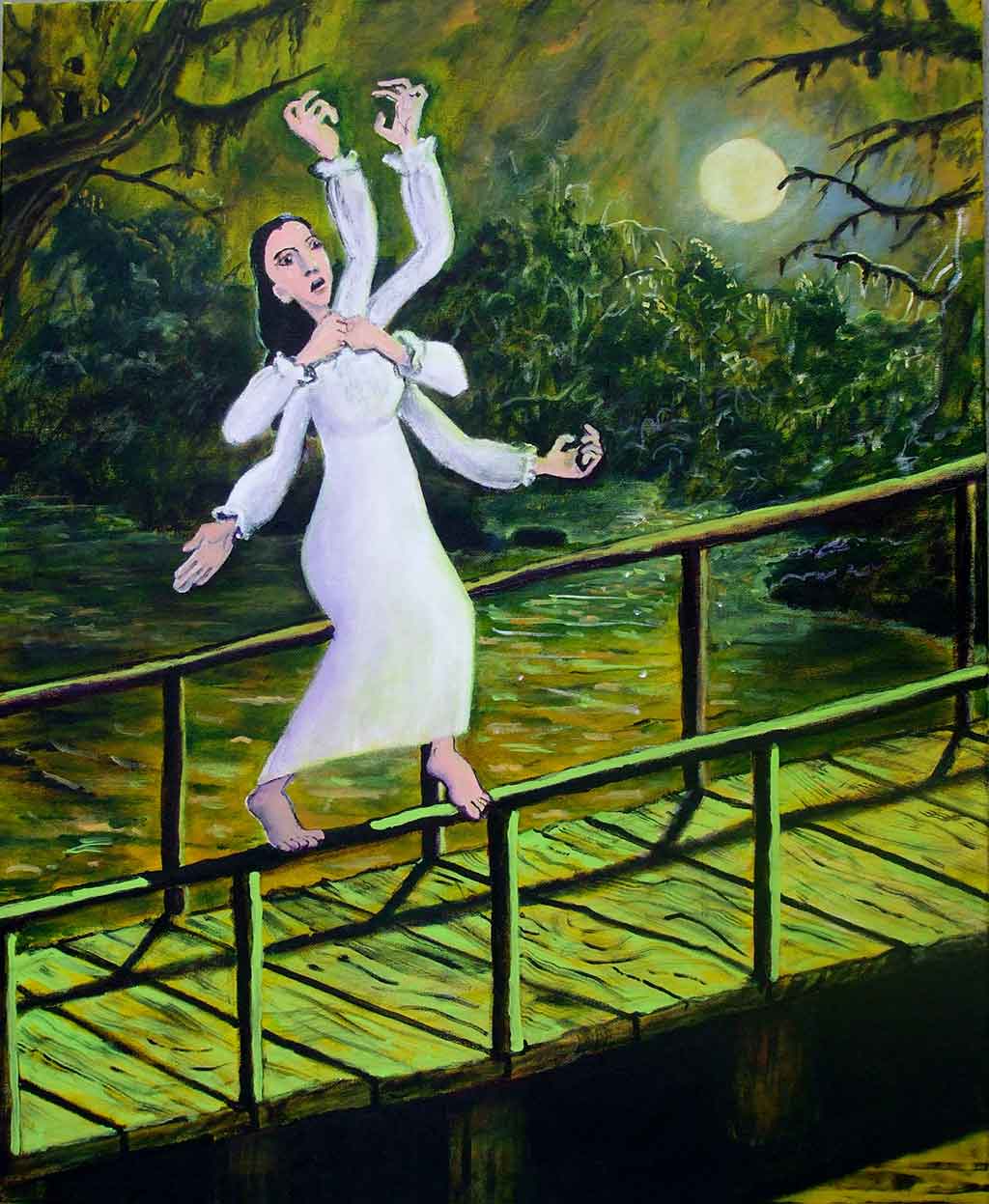
Emmeline Grangerford: Richard Bledsoe
Stuckism is not about being stuck in the past but about taking a different fork in the road. It’s been called Re-modernism in the Stuckist Manifesto, and takes the stand that Modernism started off well, but took a wrong turn and disappeared into pure idea like a puff of smoke. So we’re going back to take the untravelled fork-in-the-road to pursue art-making that’s more concrete and accessible to more people, and find out where that leads us. I have seen a resurgence of 19th century, classical style painting, but the Stuckists don’t do that. We don’t all work in the same style or use the same themes or subject matter. We all choose to be painters, but not as if rock & roll, television, cars, cinema, jazz, and the whole 20th century never happened. We’re saying, “Let’s use paint to describe our lives now.” We’re all interested in working representationally, but not necessarily with realism. (Terry Marks, The New York Stuckists)
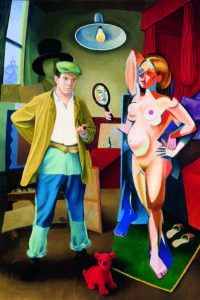
Eamon Everall
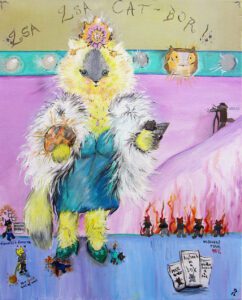
Jasmine Surreal
There is Modernism, Postmodernism and Remodernism. They are a continuum. Modernism is the great period of isms: Fauvism, Cubism, Expressionism, Surrealism, Abstractionism – those are the important ones. Then there is Minimalism which has the lack of importance its name suggests, and Conceptualism which, despite its name, has no idea at all.
Modernism was a period which valued ideals. Postmodernism was a period which devalued ideals. Remodernism is a period which revalues ideals.
Modernism began its break from the rules of Renaissance art with the Post Impressionists, who inaugurated a few decades of astonishing invention with much potential, but unfortunately and inevitably – like most of the twentieth century – Modernism’s obsession with progress succeeded in progressively losing the way and finally forgetting where it was trying to get to in the first place. This state of amnesia is called Postmodernism and is characterised by vacuous cynicism and relativism, based on underlying fear and confusion. The recovery process is called Remodernism which remembers that society in general and art in particular needs a spiritual vision of deeper meaning and genuine human values in order for people to live fulfilling lives. The focus is on art, but the principles apply universally.
The spiritual has shifted from conventional religion and is more easily understood through alternative routes, such as Carl Jung’s ideas of individuation, which necessitates an honest confrontation and integration of all aspects of oneself, including the unacceptable or “shadow” aspects denied and repressed into the unconscious.
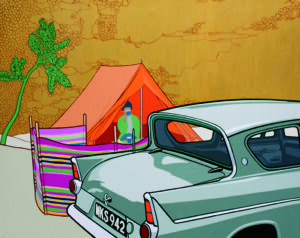
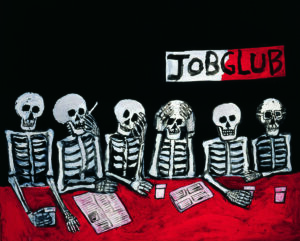
Remodernism is a development of the Stuckists art group, which I co-founded in 1999 with Billy Childish (who left after two years) to promote figurative painting with authenticity, depth and ideas. A number of people wanted to apply the basic ideas to their own painting activity, other related areas such as photography and architecture, or even non-art activities in business and society at large, so in 2000 Billy and I co-wrote the Remodernism manifesto as an umbrella to encompass this wider field. The Stuckists were then declared to be the first Remodernist art group.
The Defastenism group in Ireland declared themselves Remodernists, held gatherings, staged shows and put on cabarets. Gary Farrelly, Pádraic E. Moore and Liam Ryan were leading lights. Victoria Mary Clarke (partner of the Pogues’ Shane MacGowan) was a member. Jesse Richards launched Remodernist Film. Online painting groups include ones founded on Deviant Art by Clay Martin (aka Laniru), on MySpace by Matt Bray, and on Red Bubble by Carson Collins. They mostly seem to have petered out, although members continue individually. In the meantime the Stuckists have grown from 13 founder members to 2,500 artists in 240 groups in 50 countries, and remain the most prominent exponents of Remodernist philosophy.
The Stuckists are known and promoted as a group of figurative painters, but individual members work in most established media, including poetry, fiction, film, video, photography, demonstrations and bands. Musical former Stuckists include Billy Childish, Sexton Ming and Wolf Howard (who still takes part in Stuckist shows). Current ones are Paul Harvey (Penetration), Ella Guru (Voodoo Queens), Holly Henderson (Sex Pissed Dolls) and Black Francis (Pixies). Admittedly, Stuckists don’t then promote these other activities as art (though other people do from time to time – the Turner Prize demos earned me a conceptual art award from the proto-Mu group).
Nearly all Stuckists reject as art (though not as an odd hobby if that is what people want to do) so-called conceptual art, including – but not limited to – the display of dead animals, placards with a personal message, flea circuses, sliding doors, beds, potatoes, coat hangers, bear costumes, tins of excrement and films of people vomiting, all of which are in, or have been lauded by, the Tate Gallery.
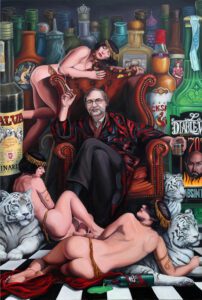
Ella Guru

Joe Machine
Stuckists do not dismiss such things out of blinkered ignorance, but from insight and experience. I staged multi-media “arts lab” events, including performance, music, and (blurry pornographic) art films in 1969 (at the somewhat precocious age of 16). Ten years later a tutor dubbed me a Postmodernist at Maidstone Art College, where my final show was a site-specific, participant-immersive enclosed maze, which included found objects, a tableau of model soldiers, and a shop with art images stuck on mundane items such as mirrors, postcards and a display of badges. (My paintings, however, were a form of punk pop art, which was highly unacceptable and I managed to be the first person to fail the degree in ten years.)
The novel ideas of conceptualism, which seemed exciting, stimulating, and provocative in theory turned out to be vacuous in practice. I returned to painting because of its expressive range and personal quality. As Black Francis has put it:
pigment on the end of my feather or finger and thrust onto the wall is … connected to my brain in a way that photography can never be. I like photography. I love film. But … The more something is processed the further away it is. Processed things can be very beautiful or interesting. Painting is RIGHT THERE.
I once posted on Jonathan Jones’ blog on The Guardian website:
It is only since ph
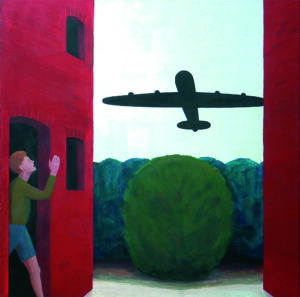
John Bourne
otography has removed from painting the need to function as documentation of the material that painting has come into its own as the true art form of expression. A photograph is a painting of the outer world. A painting is a photograph of the inner world.
An important tenet of the Remodernism manifesto is:
It should be noted that technique is dictated by, and only necessary to the extent to which it is commensurate with, the vision of the artist.
The astonishing phenomenon of Modernism meant that the artist could make up their own rules. The important qualification here is the last word of that sentence. This places a lot of responsibility on the artist and to be successful requires a high standard of unfashionable integrity and sensibility. What results is the statement of an individual soul. What emerges collectively in the Stuckists is a prodigious output in a wide range of styles, techniques and subjects united by an ethos.
Eamon Everall. who has an MA in Visual Theory, draws on Cubism and arcane systems of perspective. One of his paintings based on Van Eyck’s The Arnolfini Portrait, replaces the groom with Picasso shown naturalistically in workmen’s clothes, while the bride is rendered in a fragmented Cubist manner. Other paintings show their lineage from Cubism, but “not as we know it”. It has its own qualities of judgment, colouration and precision which bring it into the present day. It is Remodernist Cubism in fact.
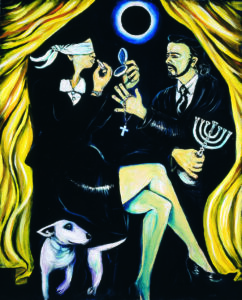
Bill Lewis
It will not come as a surprise that Jasmine Surreal makes use of the idioms of Surrealism, but not based on classic Surrealist irrationality, and what might appear at first glance to be random juxtapositions are in fact directed expositions, often deliberate reversals – a guitar playing a man or a toy cat coming t
o life as princess or film star. This is not without vituperation, particularly against the art world and the London tube system. Surrealism itself has been reversed so the seemingly meaninglessness has conceptual and emotional meaning.
Paul Harvey’s paintings often feature intricate arabesques to form a frame within the picture and have an undisguised antecedent in Alphonse Mucha. Here is a formidable example of how an earlier artist’s (commercial) wo
rk has been varied, elaborated and transformed with numerous other elements into a new visualisation, which both pays homage to and eclipses its precedent. Harvey’s forte is quotation and juxtaposition, evidenced notably in the Giotto sky behind a foreground Ford Anglia car, telescoping the centuries.
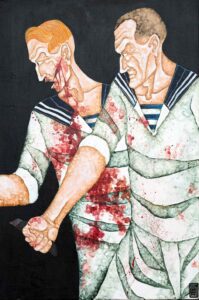
Philip Absolon appears at first sight an artist with formulaic repetition. More scrutiny reveals this not to be the case. His ideas and preparation are both thorough. The Job Club, his best known work, consists not of six identikit skeletons, but six individual portraits of people he knew. His cats, rendered in a nouveau-Cubist manner, are likewise based on intense life studies, particularly the simultaneous depiction of numerous positions of a cat in motion, which builds on Futurist innovations with his own modifications.
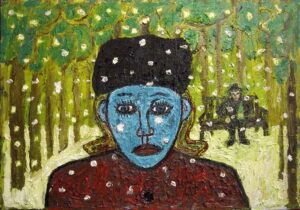
There is often an exception in an art group: in the case of the Impressionists it was Degas who did not portray landscapes with dabs of paint, but worked more in the classical mode, his contemporary subject matter and compositions bringing him into the Impressionist fold. In the case of Stuckism it is Ella Guru with a reverence for Old Master technique, which she employs to depict her own demimonde of burlesque and carnival, with particular focus on the contemporary issue of (trans-)gender. (She and her husband were married in drag.) Her superb use of colour and form brings the image to life.
Joe Machine is self taught but quickly developed his own techniques for creating anguished images of viciously fighting sailors and seemingly soulless sex with prostitutes, based on his own disturbed and criminal youth. Egon Schiele’s sexual imagery is intensified and amplified both in terms of subject and technique, but, even more interestingly, with a different potential, which Joe has realised by steadily evolving into other subjects to transcend his early obsessions. Subsequent series have shown the (failure of) the Russian Revolution, nature studies of trees and flowers, stories from the book of Genesis, and Britannic myths. It is hard to think of another artist who has moved so confidently and successfully through such disparate areas.
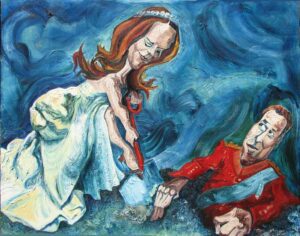
Annie Zamero
John Bourne with an MPhil in Research on Solid State Theory “did a Gauguin” by leaving his lecturing job on physics for an attic studio. He describes his work as “figurative minimalism or minimal figuration”, acknowledging a link to Morandi’s endless permutations of flatly painted dun-coloured bottles. John’s describes his work as “like bottles turned to figures: bottles have shoulders, head and neck!” His “flat” figures are produced from memories of specific occasions in real places. He uses a middle range of restrained but varied subtle colour harmonies to create images of stillness and peace.

Charles Thomson
Wolf Howard transforms the example of Van Gogh’s vigorous definitions and energised brushstrokes to state his own preoccupations, ranging from a dead bird next to a vase of flowers, and a blue-faced Russian woman in the snow, to the humour of a dog and cat underwater wearing a diving mask and goggles watching fish swim by. At first glance The Firing Squad shows a sunny garden opulent with pink blooms, until one notices at the bottom in front of a fence is a line-up of a hedgehog, a dog, a fox and three cats, at least one of the latter guilty of urinating in the artist’s slippers…
Annie Zamero follows the example of Picasso, amongst others, to make a radical reinterpretation of earlier iconic works, but in her case substituting well known contemporary figures of society, politics and commerce, including David Cameron and Rupert Murdoch, for the original subjects. A typical explanatory title is Tony Blair Turns Catholic after Portrait of Innocent X by Diego Velazquez, 1650. She portrays faces and figures as if viewed in a distorting mirror, sometimes almost to the point of unrecognisability and abstraction, placing them amidst a similar background.

Jonathan Xavier Coudrille
My own work draws from two conflicting schools – the clear defining outlines of Pop Art and the energised marks of Expressionism. I finally reached a synthesis of these after a couple of decades and call the result “Pop Figurative Abstract Expressionism”. This is the best solution I have found for communicating both ideas and emotions, and I see myself as firmly in the Remodernist camp in doing this. The subjects and the means for depicting them have equal importance, as does the primacy of pictures that can be understood in an immediate sense and, I trust, deepen over time.
Others on the roster of UK
artists include Jonathon Coudrille, who displays superb technique for his own version of Surrealism-cum-Symbolism. Adam Crosland is the opposite end of the spectrum with crude art incarnate often on bits of wood or torn cardboard, unafraid of crude subjects to match, including a fight over a “rabbit” dildo, while Jenny Westbrook silhouettes a animal black rabbit on a beautiful, misty, abstracted landscape. Emma Pugmire depicts claustrophobic cityscapes. Remy Noe depicts luminous landscapes.
Jane Kelly asks if we can undo psychosis and shows Hitler in a red jumper as a middle aged tourist in front of the Eiffel Tower. Peter Murphy should really be called a Remedievalist, using tempera paint to set Jimi Hendrix in a gold leaf altarpiece pinnacle. Mark D, formerly an indie pop musician with Fat Tulips, rivals Adam Crosland with execrable but rollicking visual “punk” satires of knickerless celebrities, puking revellers and artists of all persuasions, including me. In contrast, Charles Williams was a top student at the Royal Academy. Urination was an early subject in his work, which then shuffled through colourful living rooms, cocaine parties and shoppers to still lifes with skulls.
Justin Piperger was trained at the Slade and creates witty quickly defined images such as a solitary vertical arm with fingers curled – to make yet
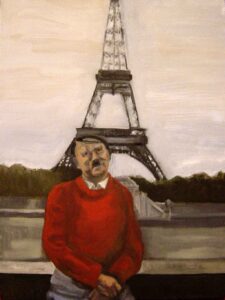
another variation of rabbit. Andrew Galbratih uses the skills of Dutch masters on still lifes with disconcerting reflections on a polished kettle. Jacqueline Jones and Chris Yates are both Remodern Expressionists, the latter in particular exploiting a concoction of drips, splodges, streaks, circles and outlines to the full.
Outside the UK, there is a strong Stuckist centre in Prague, notably with the work of Jaroslav Valecka. who views the anxious topography of Edvard Munch with serene transcendence, as if Munch had been able to take the step of curing himself of the neuroses which he nurtured as a creative font. The beauty of Valecka’s landscapes is always present to be admired and enjoyed, but he is a realist not an escapist and is sometimes prepared, or compelled, to give witness to the darker events of humanity that can occur in such soothing settings, notably the destruction of churches and killings perpetrated, at one time by the Nazis, and in Jaroslav’s own lifetime by the oppression of the former Communist government.
Jaroslav’s compatriot is Jiri Hauschka, who also focuses on landscape with a compulsion to fuse figuration and abstract, the latter incorporated in areas of black and white liquidity that take various forms and change the security of what would otherwise be a normal landscape or interior, by implying there are other forces that demand to be acknowledge beyond the surface appearance.
Like Ella Guru, Odysseus Yakoumakis in Greece uses “traditional” art techniques, sometims with distorted perspective to fuse an eclectic mix of
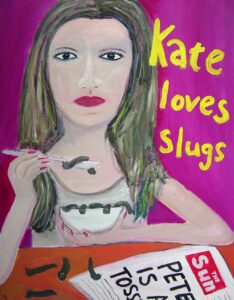
images. The subject is the focus. Lupo Sol in Spain is the inventor of quirky human tales that vary from endearing to macabre in a rough style with appropriate accomplished colours. Also in Spain, Artista Eli makes exquisite paintings like jewels. Elsa Dax oscillates between homes in England and native France, her work depicting Greek myths in a simple style with complex compositions.
America is second only to the UK in the number of Stuckist artists. A key figure at the moment is Richard Bledsoe in Arizona, who blogs art theory on a site called The Remodern Review, curates shows, and in his own work follows the example of many Modern (and Remodern) artists, who use a straightforward simplified figuration to express the conviction and variety of their ideas. Early examples of this mode are Gauguin, and the more straightforward works of Russians Larionov and Goncharova. The success is not in stylisation such as Expressionism, but the straightforwardness of the depiction of the subject. The interest is in the narration, though this has to be reinforced by a suitable aesthetic ability. Richard’s The Portrait of Emmeline Grangerford, based on a spoof drawing in Mark Twain’s Huckleberry Finn (1885) makes the subject deliberately absurd, yet at the same time more dramatic and poignant.
Ron Throop in New York State is equally as active, publishing books, curating, and setting up a strong liaison with Alexey Stepanov and other
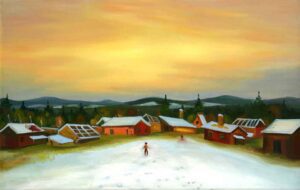
Moscow Stuckists. He may not realise it, but he has an artistic foot firmly planted in the Lowbrow art movement, described by Wikipedia as:
an underground visual art movement that arose in the Los Angeles, California, area in the late 1970s. It is a populist art movement with its cultural roots in underground comix, punk music, and hot-rod cultures of the street. It is also often known by the name pop surrealism. Lowbrow art often has a sense of humor – sometimes the humor is gleeful, sometimes impish, and sometimes it is a sarcastic comment.
His painting titles include such gems as: This Brazilian Frog Thinks His Life Chances Improve a Million-fold for Every patriotic CEO who Gives Up the Ghost and Out the East Window of My Basement Painter’s Box. The Tetrahedron Mocks Me.
Terry Marks in New York describes herself as “a painter of oddball eccentricities” and is like Jasmine Surreal in using Surrealist approaches for
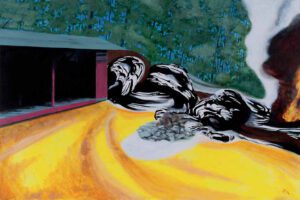
story telling. She ranges from the whimsical to the threatening, with a penchant for robots. Nightmare Mirror is amongst the most straightforward of her works, but capable of multiple interpretations. In Massachusetts, Black Francis, renowned as the front man of rock group PIxies is also a Stuckist artist and has no inhibitions about delineating odd characters, piled up on abstract backgrounds of flattish colour.
Asia is represented by Shelley Li, who is Chinese, living in London and who quaintly combines images of fashionable and sometimes erotic ladies with the fabrics of opulent interiors. There is a committed group in Tehran, founded by Hamed Dehnavi and including Farsam Sangini: on one occasion a painting of three ducks was banned by the authorities for indecency. Australasia’s foremost Stuckist is Godfrey Blow in Perth, a consummate professional in his approach to detailed landscape, selected in at least 25 art prizes, and in 2016 the official tour artist for the visit of Prince Charles and Camilla, Duchess of Cornwall.
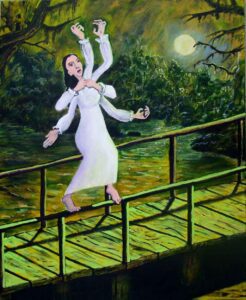
Richard Bledsoe
A new generation of Stuckists/Remodernists is emerging with Holly Henderson, born in 1995, who not only went to art college in Maidstone, as I did nearly 40 years earlier, but also, as I did, suffered opprobrium for not toeing the party line. Because she painted pictures instead of doing conceptual work she was castigated as amateurish, obsolete and with no future for her art.
Charles Thomson is an artist, writer, poet, curator, editor, photographer, promoter, publicist, and publisher. He lives in London.
Volume 32 no. 1 September/October 2017 pp 20-27
